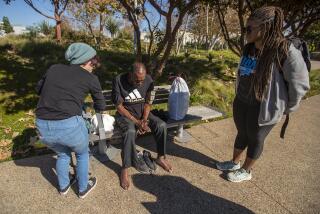Memos Tell Plan to Roust Homeless : Courts: Transient’s lawsuit cites Santa Ana documents telling of strategy to remove people’s belongings from Civic Center.
- Share via
NEWPORT BEACH — As part of a strategy to deal with transients in Santa Ana, city officials in 1988 developed an aggressive plan that included removing the belongings of homeless people from public areas, according to internal city memos introduced in court Tuesday.
The memos were shown to jurors by attorney Christopher B. Mears, who is representing Mashone Bonner, a homeless man who alleges in a lawsuit that city officials illegally confiscated his personal belongings--including lifelong mementos--and threw them away during a 1989 sweep of the Civic Center.
Mears argued that the memos demonstrate the city’s intent to “force the homeless people out of town,” and that the taking of Bonner’s property was part of that effort. Bonner has lived in the Civic Center since 1985.
The city’s attorney, Phillip D. Eaton, argued that the program did not reflect an “official” city policy, but was part of evolving efforts by the city to respond to repeated complaints from citizens about the growing problems with the homeless, loiterers, drug abusers and others living on city streets.
During opening arguments before the jury, Mears spoke of the sentimental value that Bonner had attached to his possessions, which included a diamond ring and watch that were gifts from his estranged wife, and school photographs of his three daughters.
The possessions, Mears said, were “more precious than rubies; more valuable than gold.”
But Eaton told the jury in his opening argument that Bonner did not make a concentrated effort to recover his property.
“He did not contact his ex-wife or his mother in an effort to obtain pictures or duplicates” of the personal records, Eaton said. “He did not do anything to replace those ‘diamonds and rubies.’ ”
Later, Bonner testified that he did not look for his belongings because a city parks employee told him that his possessions--including identification papers--had been disposed of at the “dump.”
And he did not pursue the matter at City Hall or the Police Department, he said, because he believes officials do not take the concerns of the homeless seriously.
“If you are homeless and you walk into the police station, you are not important, you know, and they are going to pass you right along,” he told the jury. “Unless there’s a crime I have committed, then they will. But to say, ‘Do you know where they put my bag?’ I’m wasting my time.”
The case, which is being heard in Superior Court in Newport Beach, is the first of a series of similar lawsuits against the city to go to trial. Others have been settled out of court, with the city agreeing to pay a total of about $500,000 to a number of homeless people.
Among the city memos introduced in the trial was one written in June, 1988, by Allen E. Doby, Recreation and Community Services Agency executive director. That memo said, in part: “City Council has developed a policy that the vagrants are no longer welcome in the city of Santa Ana.”
Another memo, written a day later by then-Deputy City Manager Jan C. Perkins, outlined the actions to be taken by a city staff “task force” assigned to deal with the homeless issue, including turning on the sprinklers more frequently at Center Park, where some of the homeless slept.
Perkins’ memo also stated that “the mission of this program will be to remove all vagrants and their paraphernalia out of Santa Ana by continually removing them from the places that they are frequenting in the city.”
Under questioning by Mears, Doby did not dispute the mission of the task force, but recanted his own memo, explaining: “There was probably a poor selection of words. The council had not developed a policy.”
Doby said that more than a year later, after being questioned by Perkins about his statement that a City Council policy existed, Doby wrote another memo stating he “did not intend to state or imply” that a council policy existed.
Although the task force was expected to last six months, Doby said it was in existence as late as January, 1990.
More to Read
Sign up for Essential California
The most important California stories and recommendations in your inbox every morning.
You may occasionally receive promotional content from the Los Angeles Times.













